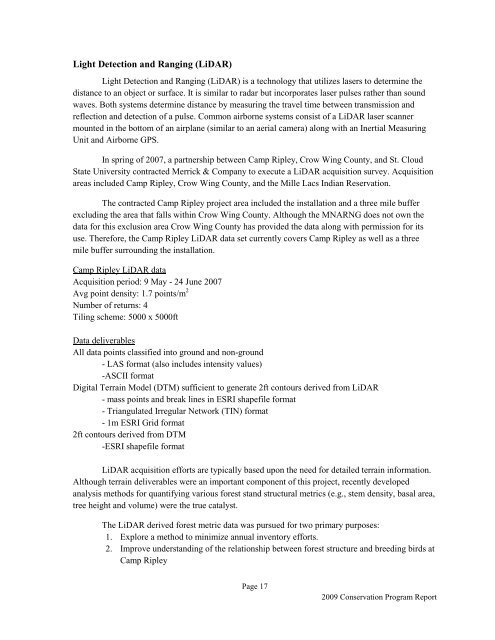camp ripley and arden hills minnesota army national guard training ...
camp ripley and arden hills minnesota army national guard training ...
camp ripley and arden hills minnesota army national guard training ...
Create successful ePaper yourself
Turn your PDF publications into a flip-book with our unique Google optimized e-Paper software.
Light Detection <strong>and</strong> Ranging (LiDAR)<br />
Light Detection <strong>and</strong> Ranging (LiDAR) is a technology that utilizes lasers to determine the<br />
distance to an object or surface. It is similar to radar but incorporates laser pulses rather than sound<br />
waves. Both systems determine distance by measuring the travel time between transmission <strong>and</strong><br />
reflection <strong>and</strong> detection of a pulse. Common airborne systems consist of a LiDAR laser scanner<br />
mounted in the bottom of an airplane (similar to an aerial camera) along with an Inertial Measuring<br />
Unit <strong>and</strong> Airborne GPS.<br />
In spring of 2007, a partnership between Camp Ripley, Crow Wing County, <strong>and</strong> St. Cloud<br />
State University contracted Merrick & Company to execute a LiDAR acquisition survey. Acquisition<br />
areas included Camp Ripley, Crow Wing County, <strong>and</strong> the Mille Lacs Indian Reservation.<br />
The contracted Camp Ripley project area included the installation <strong>and</strong> a three mile buffer<br />
excluding the area that falls within Crow Wing County. Although the MNARNG does not own the<br />
data for this exclusion area Crow Wing County has provided the data along with permission for its<br />
use. Therefore, the Camp Ripley LiDAR data set currently covers Camp Ripley as well as a three<br />
mile buffer surrounding the installation.<br />
Camp Ripley LiDAR data<br />
Acquisition period: 9 May - 24 June 2007<br />
Avg point density: 1.7 points/m 2<br />
Number of returns: 4<br />
Tiling scheme: 5000 x 5000ft<br />
Data deliverables<br />
All data points classified into ground <strong>and</strong> non-ground<br />
- LAS format (also includes intensity values)<br />
-ASCII format<br />
Digital Terrain Model (DTM) sufficient to generate 2ft contours derived from LiDAR<br />
- mass points <strong>and</strong> break lines in ESRI shapefile format<br />
- Triangulated Irregular Network (TIN) format<br />
- 1m ESRI Grid format<br />
2ft contours derived from DTM<br />
-ESRI shapefile format<br />
LiDAR acquisition efforts are typically based upon the need for detailed terrain information.<br />
Although terrain deliverables were an important component of this project, recently developed<br />
analysis methods for quantifying various forest st<strong>and</strong> structural metrics (e.g., stem density, basal area,<br />
tree height <strong>and</strong> volume) were the true catalyst.<br />
The LiDAR derived forest metric data was pursued for two primary purposes:<br />
1. Explore a method to minimize annual inventory efforts.<br />
2. Improve underst<strong>and</strong>ing of the relationship between forest structure <strong>and</strong> breeding birds at<br />
Camp Ripley<br />
Page 17<br />
2009 Conservation Program Report
















